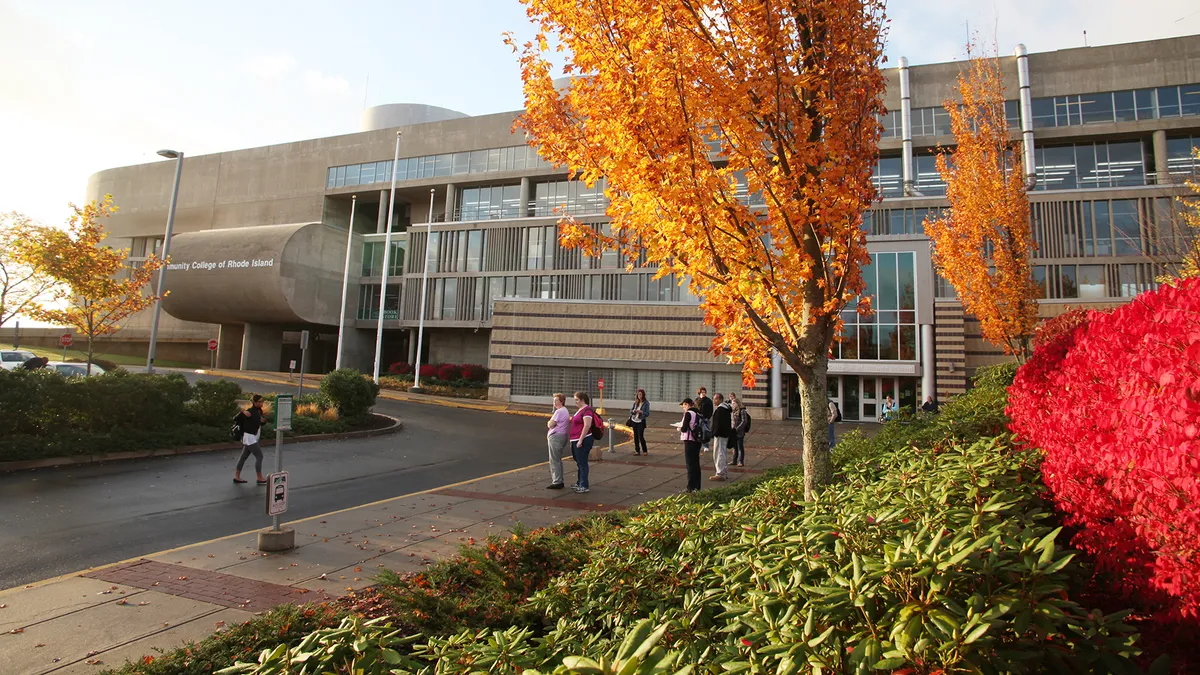The Community College of Rhode Island (CCRI) is at the nexus of several problems bedeviling higher education.
As an institution in New England, it's facing a steady decline in high school graduates that is expected to accelerate in the next decade. And as a community college, it's grappling with the twin issues of low graduation rates and wavering public support.
Yet several institutional reforms and the offer of free tuition helped the college graduate its largest class ever this year and improve on several key student outcomes.
"Our work requires relentless energy and real urgency," CCRI President Meghan Hughes told Education Dive earlier this year. "Our students don't have time to wait for us to figure this out."
They don't have to. CCRI leaders are quick to point out that other institutions have spent years experimenting with and fine-tuning initiatives and programs that are proven to boost student success.
All CCRI has had to do is follow their lead, said Sara Enright, the college's vice president for student affairs and chief outcomes officer.
"There's a first-mover advantage, but then there's a second- or third-mover benefit," she said. "That enables us to tackle a lot of things at once, whereas institutions that came before us — because they were doing so much true pioneering — maybe had to take things one at a time."
Indeed, CCRI has a lot on its plate. It's just a couple of years into rolling out a free college initiative and developing a master schedule to ensure classes are available at the times students need. And this past winter, it launched a partnership with global tech company Infosys.
It's still in the process of implementing guided pathways, overhauling its remedial education and making its advising more proactive.
The free college program, which the state approved and began offering in 2017, has "brought a greater urgency" to the other initiatives underway, Enright said. "The state is really paying attention to this program and investing in this program," she added. "It catalyzed and supports the work we're already doing."
"There's a first-mover advantage, but then there's a second- or third-mover benefit. That enables us to tackle a lot of things at once."

Sara Enright
Vice president for student affairs and chief outcomes officer, CCRI
Early results are promising. The two-year graduation rate for first-time, full-time students rose to 18% in the 2018-19 academic year after hovering around 4% for years. Students of color saw an especially large jump, from 2% historically to 12% that year.
"Young people know that higher education is the best opportunity in this country," Enright said. "They just don't always know (how you) put the pieces together to get there. … A promise program really clarifies that and simplifies that and makes college real in a way that perhaps it didn't feel for students before."
Even so, barriers remain. Students who qualified for a full Pell Grant had two-year graduation outcomes that lagged that of their peers, The Boston Globe reported.
And college accessibility experts have warned that programs like Rhode Island's — which only covers tuition and mandatory fees after other grants and scholarships have been applied — don't go far enough to help low-income students who have most or all of their tuition paid for by other aid.
To help those students cover nontuition expenses, such as textbooks and transportation, CCRI has looked to private support. Since 2017, the Hassenfeld Family Foundation has pledged $1 million to pay some of Pell Grant students' nontuition costs.
The college also hopes to raise $25 million by 2025 to add to its endowment, which is currently around $4.4 million. "We are not raising this money to buy mahogany lockers or a climbing wall," Hughes said. "What we will do ... is invest it in the college in a way that is designed to produce the most accelerated learning outcomes for our students."
That includes scholarships and emergency aid so life events like a car breakdown or an overdue electrical bill don't delay or derail a student's college career.
But convincing well-heeled donors to give large sums to the institution can be tricky, as many didn't attend community colleges, Hughes said. The key, she added, is getting them to understand the institution's students and their achievements.
"When I talk about our students, it may not be a story that is part of their own lived experience," Hughes said. "But they can look up at either a parent or a grandparent and say, 'I recognize this story. I recognize this story of someone who had to work incredibly hard for everything, including an education. And as an American, I want to invest in that.'"




 Read more
Read more





